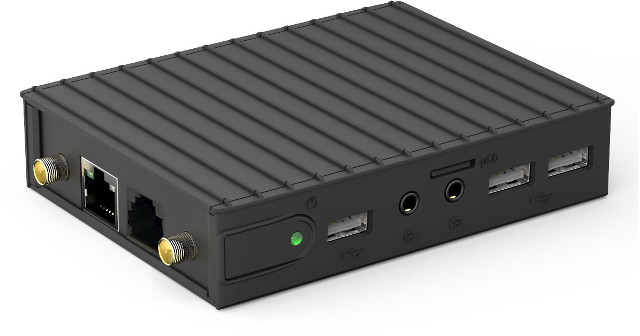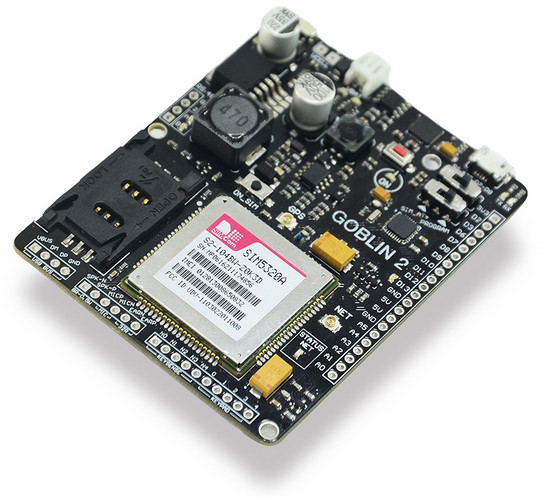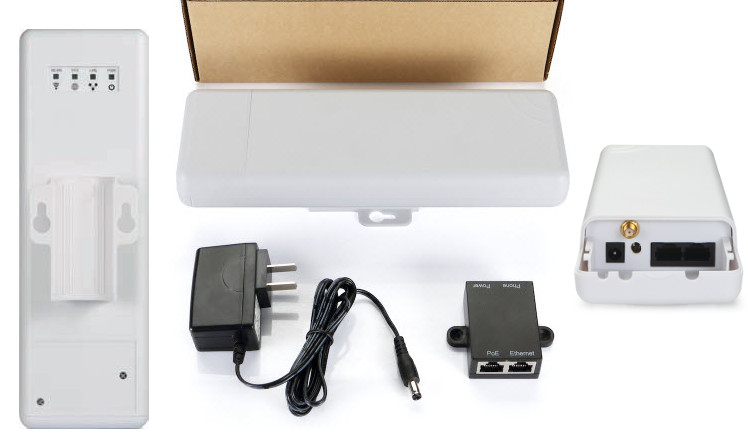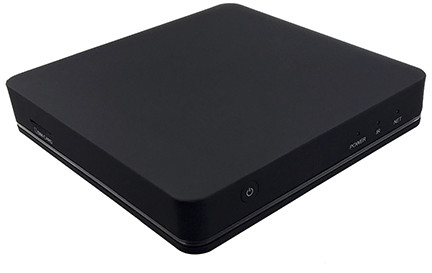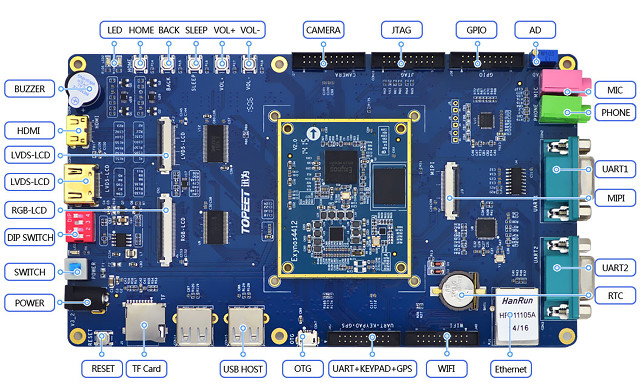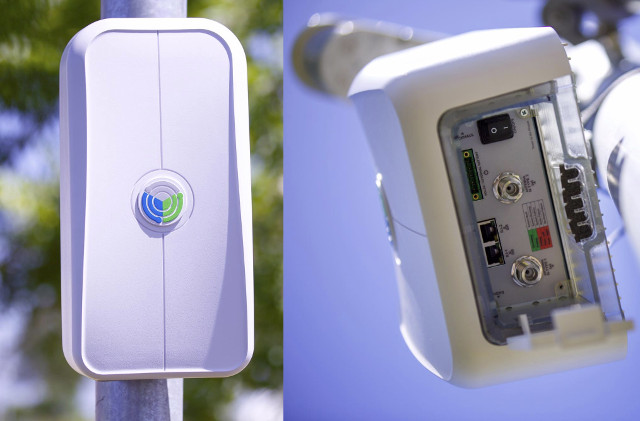CompuLab has introduced IOT-GATE-iMX7 compact fanless IoT gateway and industrial controller built around the company’s CL-SOM-iMX7 system-on-module, and offering Ethernet, WiFi, Bluetooth, 3G and Zigbee connectivity.Compulab IOT-GATE-iMX7 gateway specifications: SoC – NXP i.MX 7 dual ARM Cortex-A7 processor @ up to 1GHz with ARM Cortex-M4 core @ 200Mhz, 2D graphics engine System Memory – Up to 2GB DDR3L-1066 Storage – Up to 32GB on-board eMMC + micro-SD socket Connectivity Dual Gigabit Ethernet Dual band WiFi 802.11 a/b/g/n Bluetooth 4.1 BLE Optional 3G cellular module via mini PCie socket Optional ZigBee NXP JN5168 module Display – DVI up to 1920×1080 using a HDMI connector Audio – 3.5mm jacks for stereo line out, stereo line in USB – 4x USB2.0 host ports, type-A connectors Serial – 1x RS485 / RS422 port, RJ11 connector; 1x RS232 port, ultra-mini serial connector; 1x serial console via UART-to-USB bridge, micro-USB connector Expansion mini-PCIe socket, full-size embedded […]
Goblin 2 Arduino Compatible IoT Board Includes SIM5320A 3G & GPS Module
Veracruz, Mexico based Verse Technology has recently launched Goblin 2, an Arduino compatible IoT development, based on Atmel/Microchip ATmega328P MCU, featuring a built-in SIM5320A 3G and GPS module, supporting RS-485 communication, and providing 3.3/5 and 24V power output. Goblin 2 board specifications: MCU – Microchip Atmel ATMega328P AVR MCU @ 16 MHz with 1KB EEPROM, 32kB Flash, 2kB SRAM Wireless connectivity via Simcom SIM5320A USB 2.0 module: Dual-Band UMTS/HSDPA 900/2100MHz Quad-Band GSM/GPRS/EDGE 850/900/1800/1900MHz 1x SIM card slot High accuracy 16 channel GPS Expansion I/Os 6x ADC input with 10 bits resolution 10x digital in/out including 5 PWM RS-485 protocol @ 10Mbps for up to 256 nodes on the bus Header to Keypad, microphone and speaker for SIM I/O Misc – 8 LEDs for power, battery, networking, RS485, UART, plus one user LED; Power switch, RS-485 /GPIO switch, program / SIM AT+ switch Power Supply – 5V via micro USB port, […]
Dragino OLG01 Outdoor Single Channel LoRa Gateway Runs OpenWrt, Supports Passive PoE
Dragino Technology, a Shenzhen based startup focusing on the Internet of Things, had already designed LoRa shields & Hats for Arduino & Raspberry Pi boards which can be useful for LoRa nodes, but the company has now launched Dragino OLG01 LoRa gateway running OpenWrt that communicates with nodes over LoRa, and to the cloud using WiFi, Ethernet, or 3G/4G. Dragino OLG01 specifications: WiSoC – Atheros AR9331 MIPS processor @ 400MHz System Memory – 64MB RAM Storage – 16MB flash MCU – Atmel ATMega328P AVR MCU with 32KB flash, 2KB SRAM Connectivity 802.11 b/g/n WiFi with antenna 2x 10/100M Ethernet with support for passive PoE Optional 3G/4G module connected to internal USB socket (TBC) Semtech SX1276/78 LoRa wireless module + SMA connector (antenna not provided) up to 5~10 km range USB – 1x USB 2.0 host port Power Supply – 12V DC power jack or PoE Three models are offered with […]
$99 Ping is a Tiny GPS Tracker that Works with Bluetooth and Cellular Connectivity (Crowdfunding)
Ping GPS Tracker is really small, last several months on a charge, and works with GPS, Bluetooth, and Cellular (GSM/EDGE or HSPA/UMTS) connectivity. It helps you track kids, pets, bags, keys, bicycles, cars or anything that may be lost or stolen using your iOS or Android smartphone. Ping GPS tracker specifications: Connectivity HSPA/GSM module + embedded 3G module Bluetooth Low Energy module GPS + GLONASS module Sensor – 3-axis accelerometer Misc – Inset tactile button for check-in & SOS, LED activity indicator Battery – 300 mAh custom lithium ion battery good for about 3 months Dimensions – 34 x 34 x 12 mm (PMMA silicone & elastomer materials) Weight – About 30 grams Waterproof – Up to 10 meters You’d use GPS + cellular connectivity when you are far from the tracked asset, and Bluetooth to locate it when it’s close. A button allows for your kid to send a […]
SDMC DV8219-LTE Android TV Box Comes with a Built-in 4G LTE Modem
Most users connect their TV boxes to the Internet through WiFi or Ethernet, but in some specific use case, such as digital signage in mass transport or in remote locations, it might be useful to get access to cellular networks. We’ve seen a few Android TV boxes with a built-in 3G modem in the past including CS918S and MBX-3G, but the former is based on the rather old Allwinner A31s processor, and the latter did not raise enough found on Indiegogo. But there’s nothing new, as SDMC DV8219-LTE is a more recent TV box powered by Amlogic S905X processor and running Android 6.0, equipped with a 4G LTE modem. SDMC DV8219-LTE TV box specifications: SoC – Amlogic S905X quad core Cortex A53 processor @ up to 1.5 GHz with a Mali-450MP GPU System Memory – 1GB DDR3 SDRAM (2GB as option) Storage – 8GB eMMC flash (4 to 64GB as […]
TOPEET iTOP4412 Exynos 4412 Boards Support Up to 3 LCD Displays, GPS, 3G, 4x UARTs, etc…
Beijing TOPEET Electronics iTOP4412 board based on Samsung Exynos 4412 quad core Cortex A9 processor, and a developer has very recently committed patchsets to mainline Linux kernel to add support for the board. Exynos 4412 is not quite the latest and most powerful processor, but the board is still interesting due to mainline Linux support, and some hardware features like interfaces for up to 3 LCD displays plus HDMI, two DB9 serial interfaces, two camera interfaces, and more. iTOP4412 is comprised of the company’s Exynos 4412 SoM and a baseboard with the following specifications: SoC – Samsung Exynos 4412 quad-core Cortex A9 clocked at up to 1.4GHz-1.6GHz + ARM Mali-400MP4 GPU @ 440MHz System Memory – 1 GB dual channel DDR3 Storage – 4GB eMMC flash and microSD slot Video Output / Display IF – HDMI 1.4 port, 2x LVDS interfaces (including one via an HDMI connector?), 1x LCD RGB […]
The Internet of Bridges? Connected and Solar Powered Systems for Rainfall and Stream Water Level Monitoring
We often drive on a bridge fitted with some solar powered equipment, and recently they added a solar powered camera pointing towards the river, so I became curious and decided it would be fun to have a look, and find out what it was all about. There are now 3 solar powered and connected systems. The first system has a larger solar panel connected to a Bosch camera, and a white box… The sticker on the box gives away the purpose of the system: “National Disaster Warning Center” If we look the other side of the system we’ll see an antenna (for 3G/LTE?) as well as a light pointing down to a scale to measure the water level… Probably not the most cost effective way of checking out the level, but it works, and they should have a live feed in case something goes very wrong, and it might be […]
OpenCellular is Facebook’s (soon to be) Open Source Wireless Access Platform
A few months after Canonical and Lime Micro LimeSDR open source software defined radio aiming to be used as a development platform, but also as the base for low cost cellular or other wireless base stations, Facebook has announced their own open source wireless access platform with OpenCellular project whose goal is to lower the cost of Internet connectivity in remote areas where the infrastructure does not exist. This is how Marc Zuckerberg summarizes the project: We designed OpenCellular as an open system so anyone — from telecom operators to researchers to entrepreneurs — can build and operate wireless networks in remote places. It’s about the size of a shoe box and can support up to 1,500 people from as far as 10 kilometers away. Along with our solar-powered aircraft Aquila and high-bandwidth laser beams, OpenCellular is the next step on our journey to provide better, more affordable connectivity to […]


